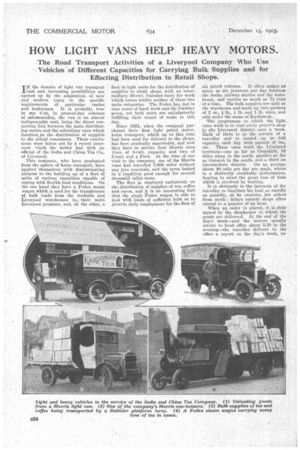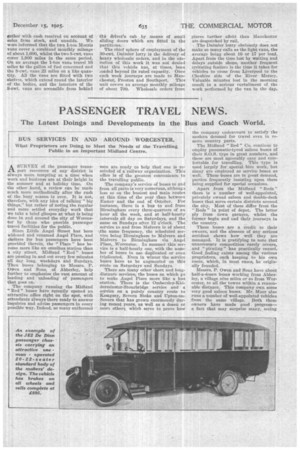HOW LIGHT VANS HELP HEAVY MOTORS.
Page 20

Page 21

If you've noticed an error in this article please click here to report it so we can fix it.
The Road Transport Activities of a Liverpool Company Who Use Vehicles of Different Capacities for Carrying Bulk Supplies and for Effecting Distribution to Retail Shops.
IN the domain of light van transport vast and increasing possibilities are opened up by the adaptation of new and modern types to the specific requirements of particular trades and businesses. It is probably true tO say nal, in present-day schemes of salesmanship, the van is an almost indispensable unit, being the direct connecting link between the main distributing centre and the subsidiary ones which function in the distribution of supplies to the actual consumers. These conclusions were borne out by a recent interview -viich the writer had with an official of the India and China Tea Co., of Liverpool.
This company, who have graduated from the sphere of horse transport, have applied themselves with discriminating purpose to the building up of a fleet of units of various capacities capable of coping with flexible load conditions. On the one hand they have a Foden steam wagon which is used for the transference of bulk loads from the dockside and Liverpool warehouses to their main Liverpool premises, and, on the other, a
fleet ot light units for the distribution of supplies to retail shops, with an intermediary 30-cwt. Daimler lorry for work which comes within neither of these two main categories. The Foden has put in nine years of hard work and the Daimler seven, yet both units are satisfactorily fulfilling their round of tasks to this day.
Since 1921, when the company purchased their first light petrol motor, horse transport, which up to this time had been used for delivery to the shops, has been gradually superseded, and now they have in service four Morris vans (two of 8-cwt. capacity and two of 1-ton) and a Ford. At the time of our visit to the company, one of th,e Morris vans had travelled 7,000 miles without any tyre renewals, and the tyres looked in a condition good enough for several thousand miles more.
The fleet is employed exclusively on the distribution of supplies of tea, coffee and cocoa, and it is an interesting fact that the single Foden wagon is able to deal with loads of sufficient bulk as to provide daily empleyment for the fleet of six petrol vehicles. It often makes as many as six journeys per day between the docks, railway station and the warehouse, and carries as much as 74 tons at a time. The bulk supplies are split at the warehouse and made up into packets
of 2 oz., lb., lb. and 1 lb. sizes, and sold under the name of Kardomah..
The programme to which the light vans work is to visit every grocer's shop in the Liverpool district once a week. Each of them is in the service of a traveller and is loaded up to full capacity each day with parcels of tea, etc. Three vans work the Liverpool territory—one us far as Ormskirk, 12 miles away in the north, another as far as Garston in the south, and a third an
intermediate district. On an average about 40 calls per day are made, whico is a distinctly creditable performance, bearing in mind the great loss of time which is involved by waiting.
It is obviously in the interests of the traveller to liquidate his load as rapidly as possible, as be executes his orders from stock ; delays outside shops often extend to a quarter of an hour.
When an order is placed, it is ,duly signed by the shopkeeper to whom the goods are delivered. At the end of the day's work—and . the motors usually return to head office about 5.30 in the evening—the traveller delivers to the office a report on the day's work, to ceether with cash received on account Of
sales from stock, and unsolds. We were informed that the two 1-ton Morris vans cover a combined monthly mileage of about 1,600, whilst the two S-ewt. vans cover 1,800 miles in the same period. On an average the 1-ton vans travel 16 miles to the gallon of fuel consumed and the 8-cwt. rams 22 miles on a like quantity. All the vans are fitted with two .13heiv2s, which extend round the interior of the bodies, and the interiors of the 8-ewt. vans are accessible from behind
the driver's cab by means of small sliding doors which are fitted in the nartitions..
The chief sphere of employment of the 20-cwt. Daimler lorry is the delivery of heavy wholesale orders, and in the execution of this work it was not denied that this vehicle has, at times, been loaded beyond its rated capacity. Once each week journeys are made to Manchester, Preston and Southport. This unit covers an average monthly mileage of about 700. Wholesale orders from places farther afield than Manchester are despatched by rail.
• The Daimler lorry Obviously does not make so many calls as the light vans, the average beiug about 16 or 17 per load. Apart from the time lost by waiting and delays outside shops, another frequent irritating feathro is the time it takes for vehicles to cross from Liverpool to the Cheshire side of the River Mersey. Valuable minutes lost in the morning result in a serious curtailment of the work performed by the van in the day.




























